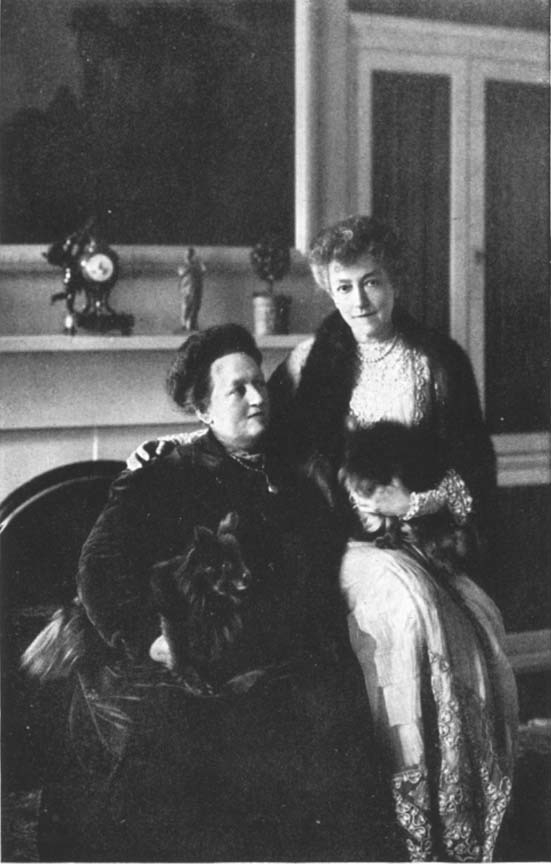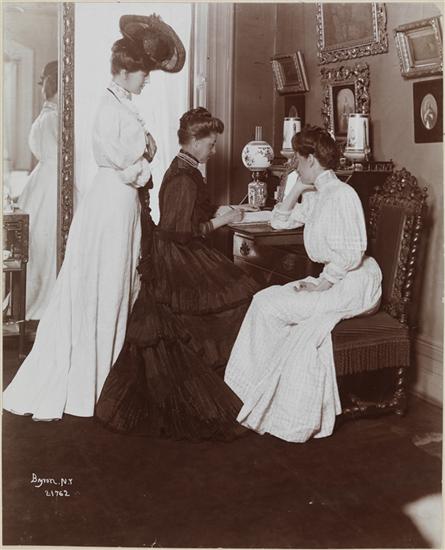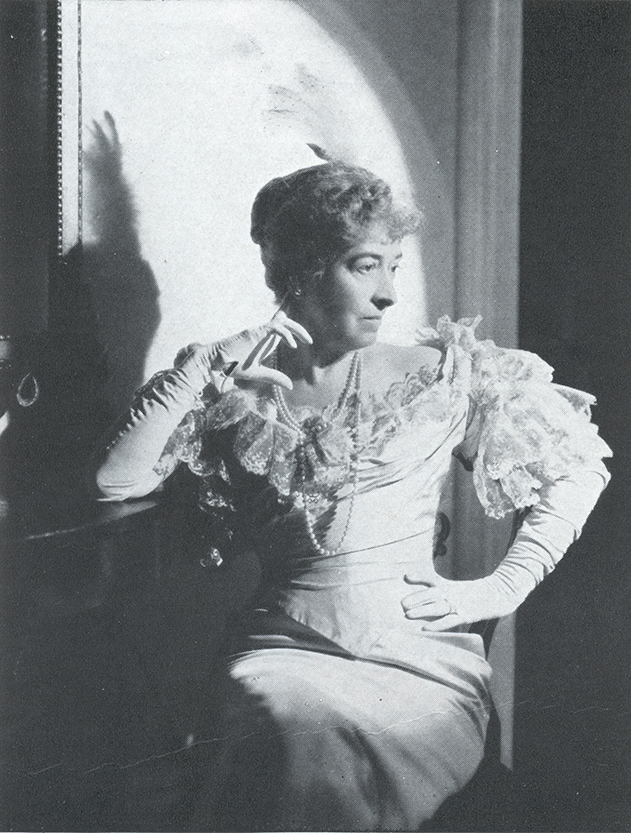Two years ago, we launched a series of monthly blogs titled “Meet the Hewitts” in order to provide a social history of the Cooper Union Museum and its founders—sisters Sarah and Eleanor Hewitt—from 1859 to Sarah Hewitt’s death in 1930. We are supplementing that history with “Cooper Hewitt Short Stories,” brief observations about prominent figures in Sarah and Eleanor’s world and how the museum developed after 1930.
Margery Masinter, Trustee, Cooper Hewitt, Smithsonian Design Museum
Sue Shutte, Historian at Ringwood Manor
Matthew Kennedy, Publishing Associate, Cooper Hewitt, Smithsonian Design Museum
Best Friends
Like Sarah and Eleanor Hewitt, friends of the sisters were privileged women, career pioneers, and philanthropists. Elizabeth (“Bessy”) Marbury and Elsie de Wolfe are perfect examples. Marbury pioneered a new profession as a talent agent for writers and performers, as well as a theater producer. Elsie de Wolfe “invented” the profession of interior decorating. Anne Tracy Morgan, Susan Dwight Bliss, and Edith Malvina Wetmore were wealthy philanthropists, collectors, and donors to the Cooper Union Museum. Caroline King Duer was a writer-poet-artist who became an editor at Vogue magazine.

Elizabeth Marbury, age 10
Elizabeth Marbury (1856–1833) grew up in the Gramercy Park neighborhood with the Hewitt sisters, where “everyone seemed to know everyone else.” In her autobiography, My Crystal Ball (1923), she wrote that “the Hewitt house at 9 Lexington Avenue was the center of all that was the best socially, intellectually, and artistically in New York.” Bessy, Sally, and Nelly (their nicknames) shared riotous childhood escapades together and were life-long friends.
A distinguished professional in her field, Elizabeth Marbury’s clients ranged from playwrights Oscar Wilde and George Bernard Shaw to the dance team of Vernon and Irene Castle, and many more. In 1916, she produced Cole Porter’s first Broadway musical, See America First.

Elizabeth Marbury and Elsie de Wolfe
In 1886, the Hewitt sisters introduced Elizabeth Marbury to Elsie de Wolfe (1859–1950). The future interior decorator was then a was young amateur actress performing in a popular play called A Cup of Tea for the opening of the posh Tuxedo Club, near the Hewitt country home in Ringwood, New Jersey. Marbury recalled in My Crystal Ball:
“It was soon after my visit to Tuxedo, and through my interest in the amateur stage, that I met Elsie de Wolfe. My friends, the Hewitts, asked us to luncheon. Caroline Duer, who had written some quite lovely sonnets, had given me copies of them. . . . I took Miss de Wolfe aside, showed her these verses and asked her to read them aloud, which she did, with a very pleasurable appreciation of their quality.”
This was a beginning of a partnership that lasted almost forty years. Elsie’s career as an actress ended as she became recognized for her good taste in advising her social friends to banish Victorian fussiness and decorate with stylish elegance. In 1905, she created interiors for the Colony Club, the first private social club for women, founded by Florence J. Harriman, Anne Tracy Morgan, Elizabeth Marbury, and Anne Vanderbilt. The Hewitt sisters were also founding members. The interior decoration of the club established Elsie de Wolfe’s immense reputation. Chic and energetic and with a great business sense, she grew an international client list. At age 61, she married Lord Mendl, a marriage in name only, giving her the title Lady Mendl.

Interior of Colony Club, Trellis Restaurant

Textile fragment, 1750–1800; Woven silk; Gift of Elsie de Wolfe, 1896-25-1; Cooper Hewitt, Smithsonian Design Museum

Anne Tracy Morgan
In 1905, Elsie de Wolfe, Elizabeth Marbury, and Anne Tracy Morgan (1873–1952) purchased, restored, and redecorated the Villa Trianon in Versailles, France. Morgan, youngest daughter of the financier J.P. Morgan, pursued a career as a philanthropist and advocate for women’s rights. These three women became known as the “Versailles Triumvirate,“ hosting fabulous parties. During World War I, they converted the long gallery of the Villa Trianon for use as a hospital ward and participated in relief work for French and, later, American soldiers.
From 1917 to 1921, Morgan took residence near the French front at Blèrancourt and largely financed a formidable help organization—The American Friends of France—which provided health services, housing, and food to soldiers and displaced refugees. The Hewitt sisters actively helped raise funds for the AFF. A wartime visitor to France in 1917 and 1918, Caroline Duer pasted “Photographs of Miss Morgan’s Headquarters” in the Ringwood guestbook entry dated September 23, 1918.

(left to right) Front view of Blèrancourt; Duer at a “regimental fête”; Soldiers’ theater.
Both Susan Dwight Bliss (1882–1966), philanthropist and collector, and her mother Mrs. George T. Bliss were close to the sisters. Long, affectionate letters between them describe a warm friendship. Susan never married and lived with her mother in a grand house built in 1908 at 9 East 68th Street. They summered together in various social resorts, including Newport, the Hamptons, and Bar Harbor. After her mother died in 1924, she continued to add to her parents’ collections of rare books and manuscripts and fine decorative arts. Upon Sarah’s death in 1930, Susan served as a director of the Cooper Union Museum for many years and was a generous donor. Susan was a dedicated volunteer and patron of New York City hospitals. Libraries at Princeton, Yale, and Bowdoin are beneficiaries of her collections of rare books.

Signatures of Jeanette Dwight Bliss and Susan Dwight Bliss from the guestbook of Ringwood Manor, 1918.

“Welcome,” stain glass window by John LaFarge for the Bliss House. Susan Bliss purportedly posed as Andromeda. Collection of Metropolitan Museum of Art. Gift of Susan Dwight Bliss, 1944.
Edith Malvina Wetmore (1870–1936) was another close friend of Sarah and Eleanor. A daughter of George Peabody Wetmore, governor of Rhode Island and U.S. Senator, and Edith Malvina Keteltas Wetmore, she was an avid traveler, arts patron, and passionate gardener. Personal letters reveal that Eleanor advised her on travels in France. One letter details how Sarah collected seeds of the Umbrella Pine and Black Cypress from Lake Garda in Italy for Edith to plant (of course, with very careful instructions for her gardener!). The Wetmore family owned a palatial estate—Château-sur-Mer—in Newport, Rhode Island, where the Hewitt sisters were house guests. Edith was a volunteer for the Cooper Union Museum and served as a director, along with Susan Dwight Bliss and Mrs. Montgomery (Constance) Hare after Sarah died. She and her sister Maude were generous donors to the museum, gifting over 243 objects of decorative arts, textiles, wallcoverings, and prints.

Edith Wetmore, 1894. Collection of the New York Historical Society

Gifts of Edith Wetmore. (Left) Radiator, USA, mid-19th century; Manufactured by Stratton & Seymour; Cast iron; 240 x 81.3 x 38.1 cm (7 ft. 10 1/2 in. x 32 in. x 15 in.); Gift of Edith Wetmore, 1918-43-1-a/j. (Top right) Drawing, Design for a Marquetry Piano Case, 1916; Designed by Durr Freedley; Graphite and watercolor on card stock; 38.3 x 47.3 cm (15 1/16 x 18 5/8 in.); Given by Miss Edith Wetmore, 1939-79-7. (Bottom right) Sample books, France, 1937; Manufactured by Olré Tissus; Silk, linen, paper, celluloid; 16 x 10.2 cm (6 5/16 in. x 4 in.); Gift of Edith Wetmore, 1937-74-8-a/z.
Matthew will now talk about his favorite “best” friend of the Hewitt sisters—the very talented Caroline King Duer.
Caroline King Duer (1865–1956) wrote an article for Vogue in 1948 titled “The Years Behind Me” that stated, “Having always longed to grow up, it appears to me now that I never have grown up. But I no longer care.” As a writer, poet, playwright, essayist, and Vogue editor, this flippant self-awareness characterized a sense of humor at once witty and insightful that pervaded her work, and coincidentally made her a perfect match for an amusing friendship with Sarah and Eleanor. Her mother, Elizabeth Wilson Meads, and her sister, Alice Duer MIller, were also writers, and the two sisters released a book of poetry together in 1896 (praised by the St. Louis Post as “Two Swell New York Sisters Have Been Wooing the Muses”).

Alice Duer Miller (left) and Caroline King Duer (right) with their mother, photographed in 1906. From the collection of the Museum of the City of New York.
In a Vogue article of the same year, titled “In the Non-Eccentric Nineties,” Duer reflected on her youth, as a child of the Gilded Age. She decried the harsh “burlesquing” of the Gilded Age by her contemporaries, who criticized the era as an extravagant whim and the people as wild eccentrics. Instead, she focused on the kind and generous personalities of those in her childhood social circles, specifically mentioning the warm hosting talents of Mrs. Hewitt and remembering that people often simply showed up at the Hewitt home for dinner:
“I think the impromptu company was sometimes more fun, since those who arrived came, not because they were engaged to come, but because they had an urgent wish to be with the Hewitts at the particular time. There was an easy friendliness in that house missed in more ceremonious places.”
As a longtime friend of the Hewitts, Duer was a guest at all of the Hewitt residences, including Ringwood Manor, where she had her own regular room and was a prolific contributor to the estate’s colorful and often comical guestbooks.
Shortly after Duer entered society around 1883, her grandfather died and she channeled her mourning into the study of nursing, later utilizing that training by working a year in Ris-Orangis, France, caring for wounded World War I soldiers. In 1918, she published Some Verses on the War: For the Benefit of the American Fund for French Wounded, a collection of poems on the need for patriotism.

Some Verses on the War, a small collection of poetry by Caroline King Duer. Courtesy of Barnard Archives
After World War I, she took a position writing and editing at Vogue, commenting on fashion, decorative arts, and etiquette (“I tried not to be humorous because Mr. [Condé] Nast always said people wouldn’t like humour mixed with manners, but I’m not sure I always succeeded.”).

The editorial staff of Vogue, photographed in New York in 1923, picturing Caroline King Duer (seated, second from the right) and Carmel Snow (seated, third from the left) who would later become the famed editor of Harper’s Bazaar.

Duer modeled garments from the Hewitt sisters’ fashion collection in a 1931 article for Vogue titled “The Undying Quality of Style.”
Amidst all of this, she was most prolific in her poetry and short stories, writing continually for weekly magazines like Ainslee’s, Scribner’s, Putnam’s Monthly, and Harper’s.
In a 1919 poem by Duer titled “To Sally and Nelly Hewitt,” the final stanza praises:

Excerpt from “To Sally and Nelly Hewitt,” by Caroline King Duer, 1919.
Ladies living, indeed!
Resources
Elizabeth Marbury. My Crystal Ball. New York: Boni and Liveright, 1923.
Elsie de Wolfe. The House in Good Taste. New York: The Century Co., 1913.
“The 1907 Bliss Mansion—No. 9 East 68th Street.” Daytonian in Manhattan. November 7, 2012. http://daytoninmanhattan.blogspot.com/2012/11/the-1907-bliss-mansion-no-9-east-68th.html.
“Ringwood Manor Guest Books.” Ringwood Manor. http://www.ringwoodmanor.org/ringwood-manor-guest-books.html.
Caroline King Duer Papers, Barnard Archives and Special Collections. Duer’s archive contains scores of poems, short stories, and articles, many in handwritten, typeset, and published forms. Barnard additionally holds the archives of Alice Duer Miller and the rest of the Duer family. “Reminiscense,” her personal history recorded for the Columbia Oral History Project, was adapted into the aforementioned “The Years Behind Me” for Vogue.

One thought on “Cooper Hewitt Short Stories: Best Friends”
Ruthie Aller on May 11, 2019 at 12:46 am
Good blog you have here.. It’s hard to find good quality writing like yours these days. I seriously appreciate individuals like you! Take care!!